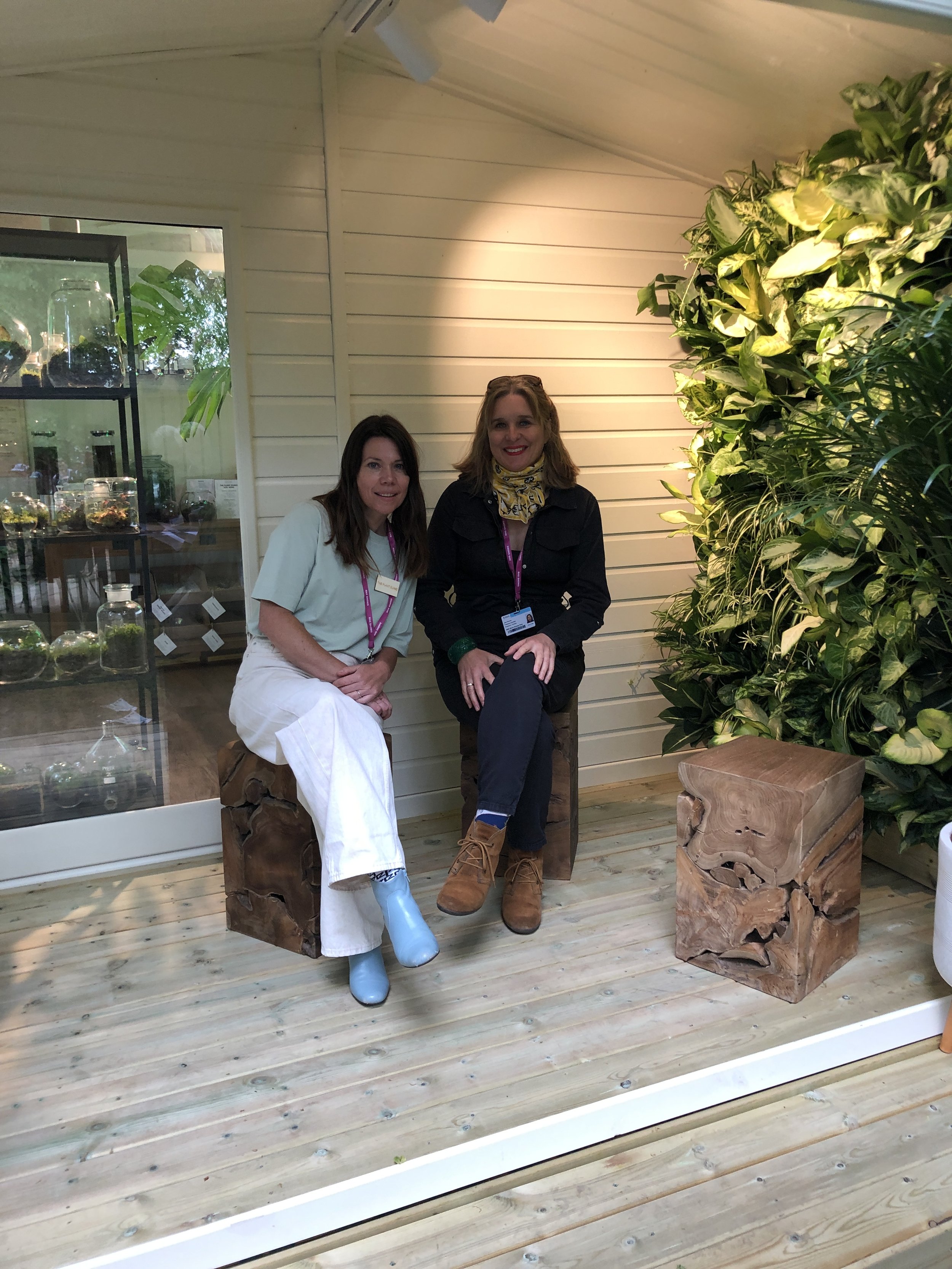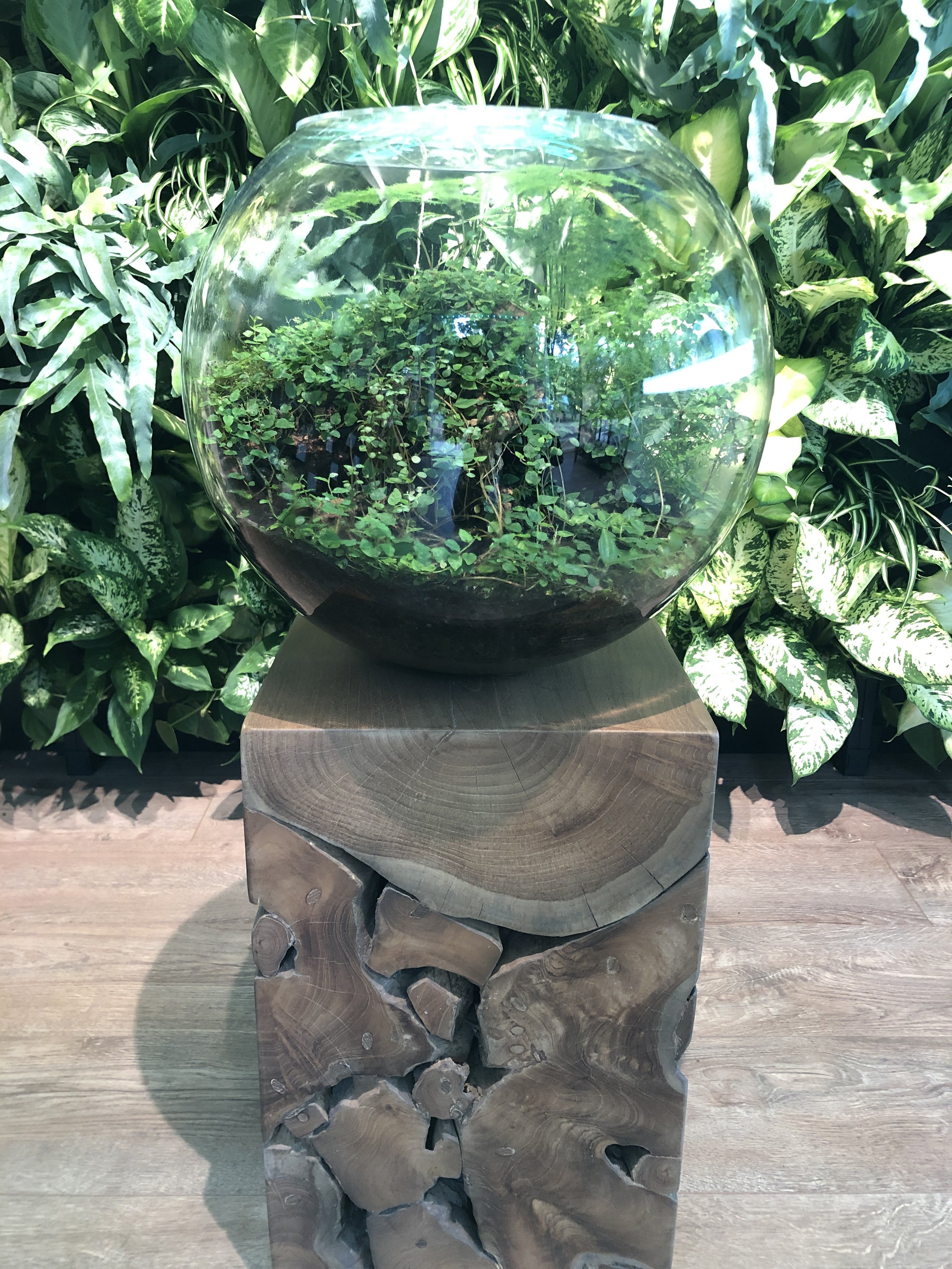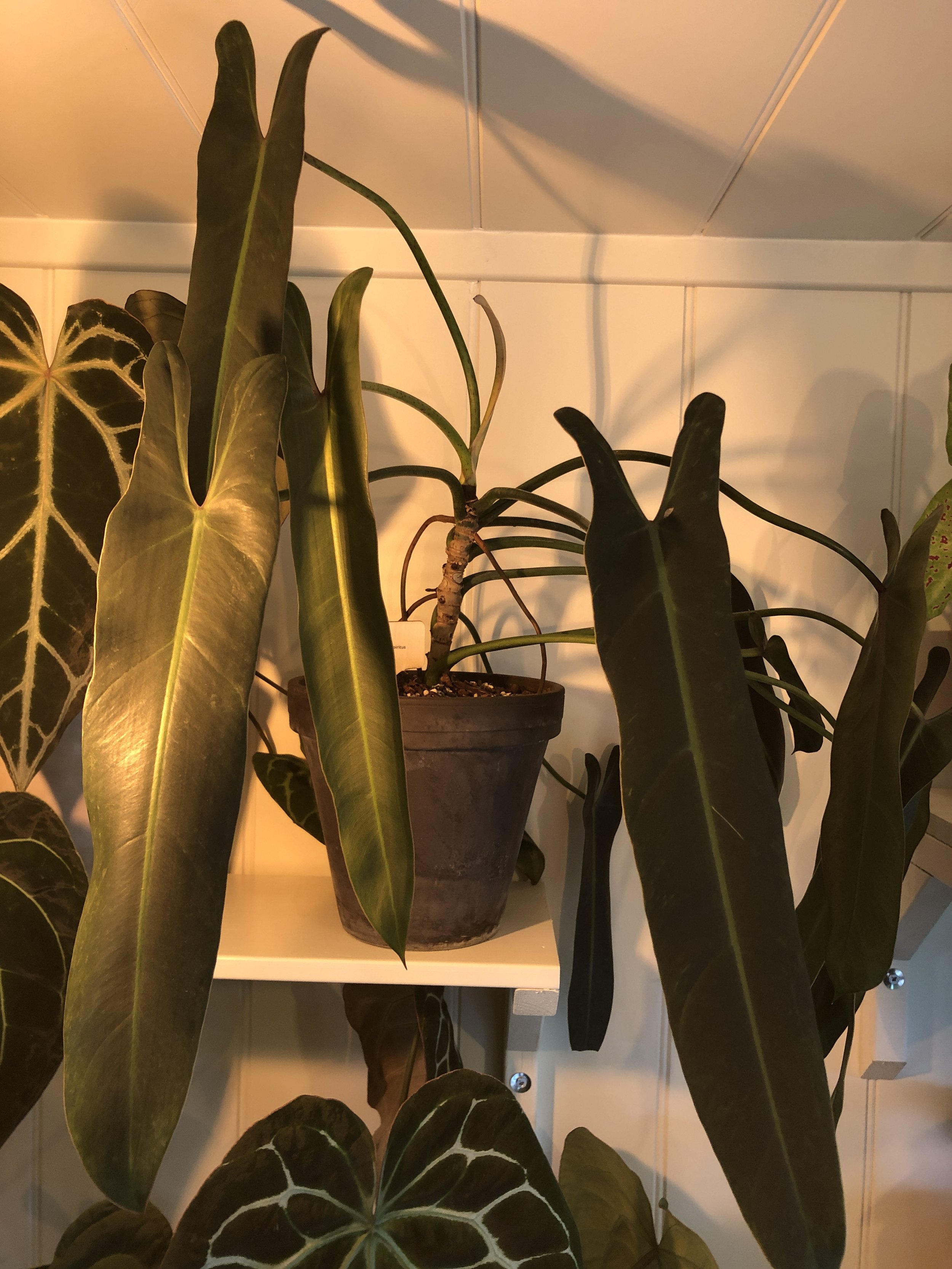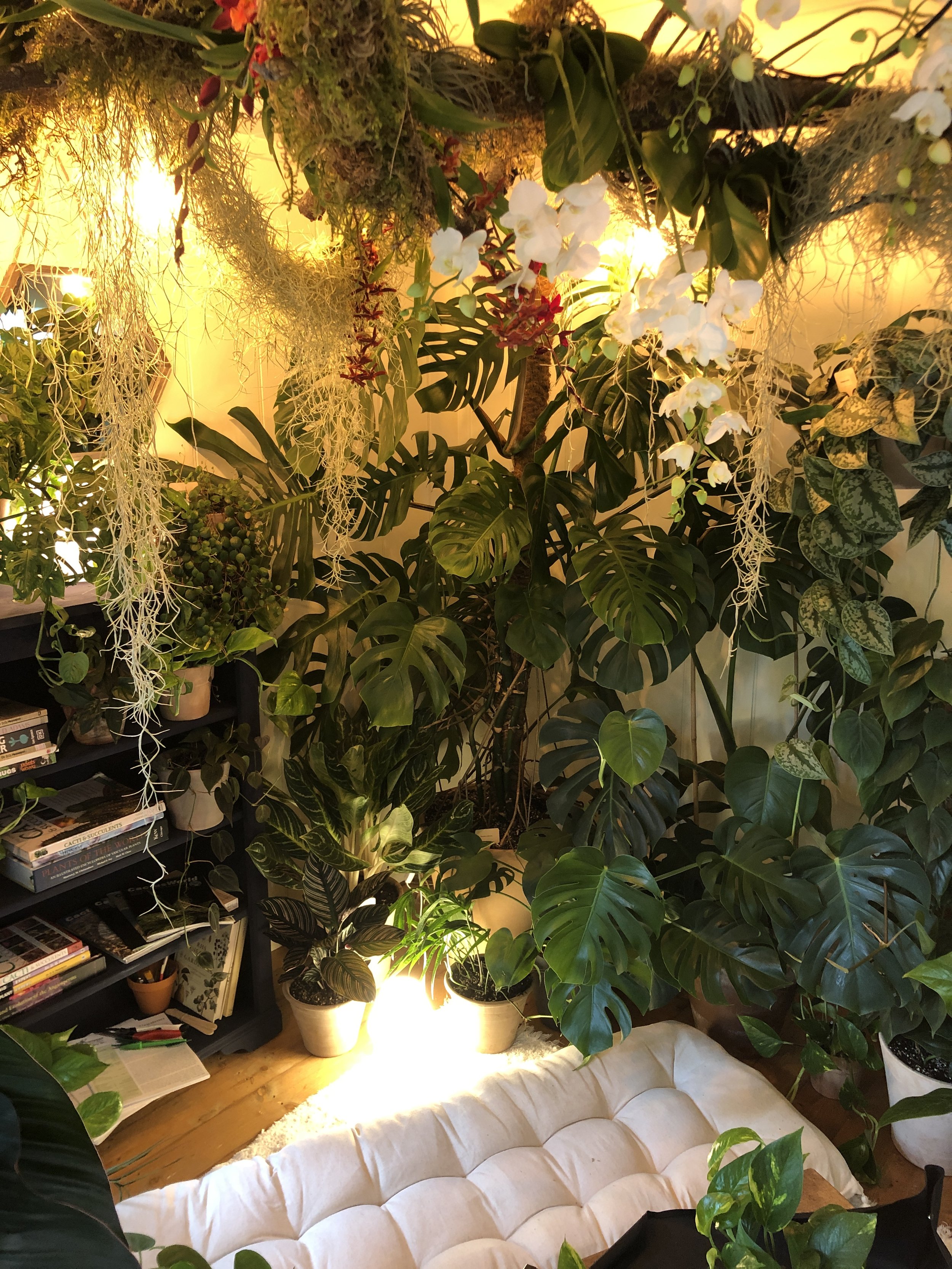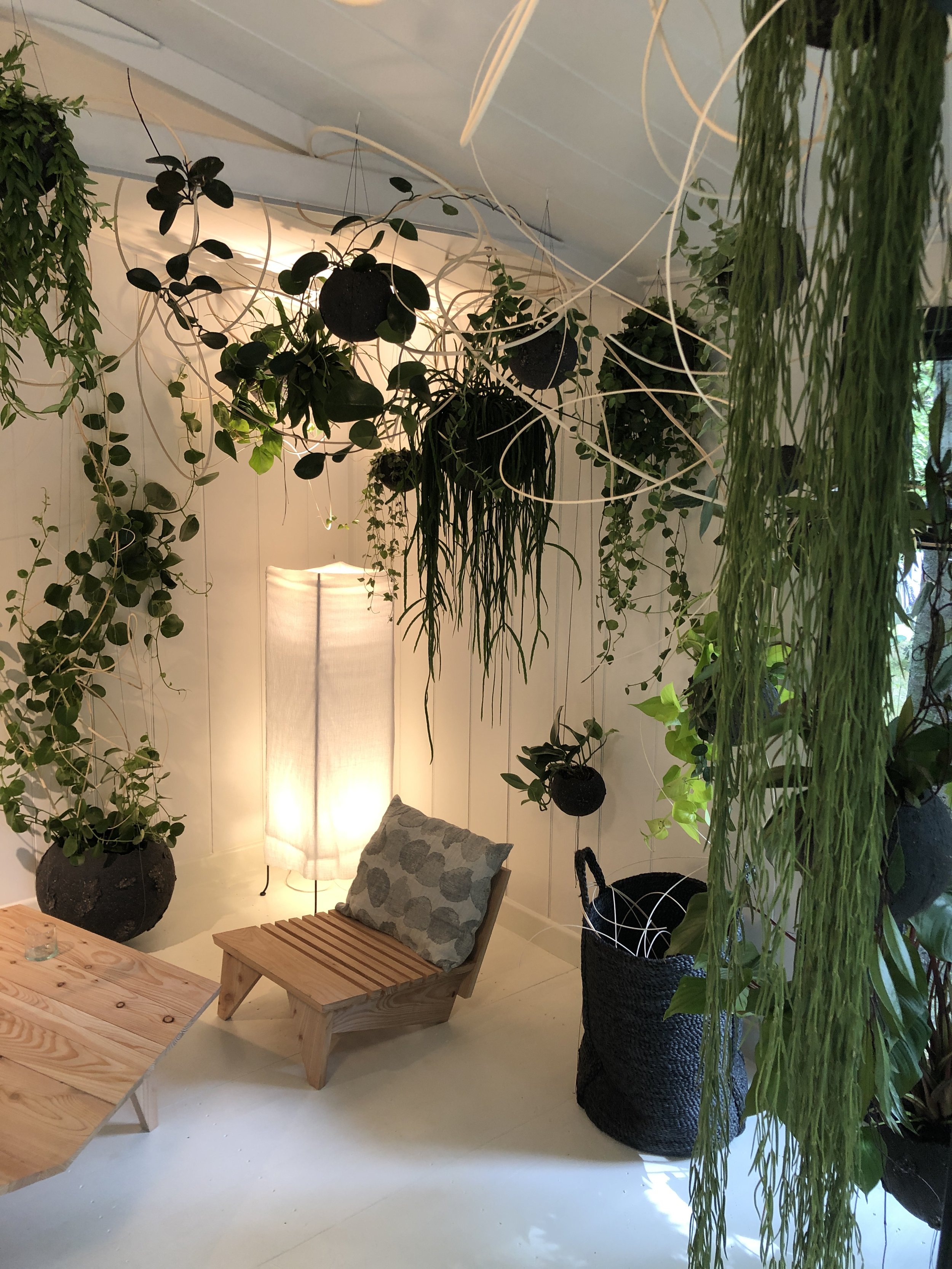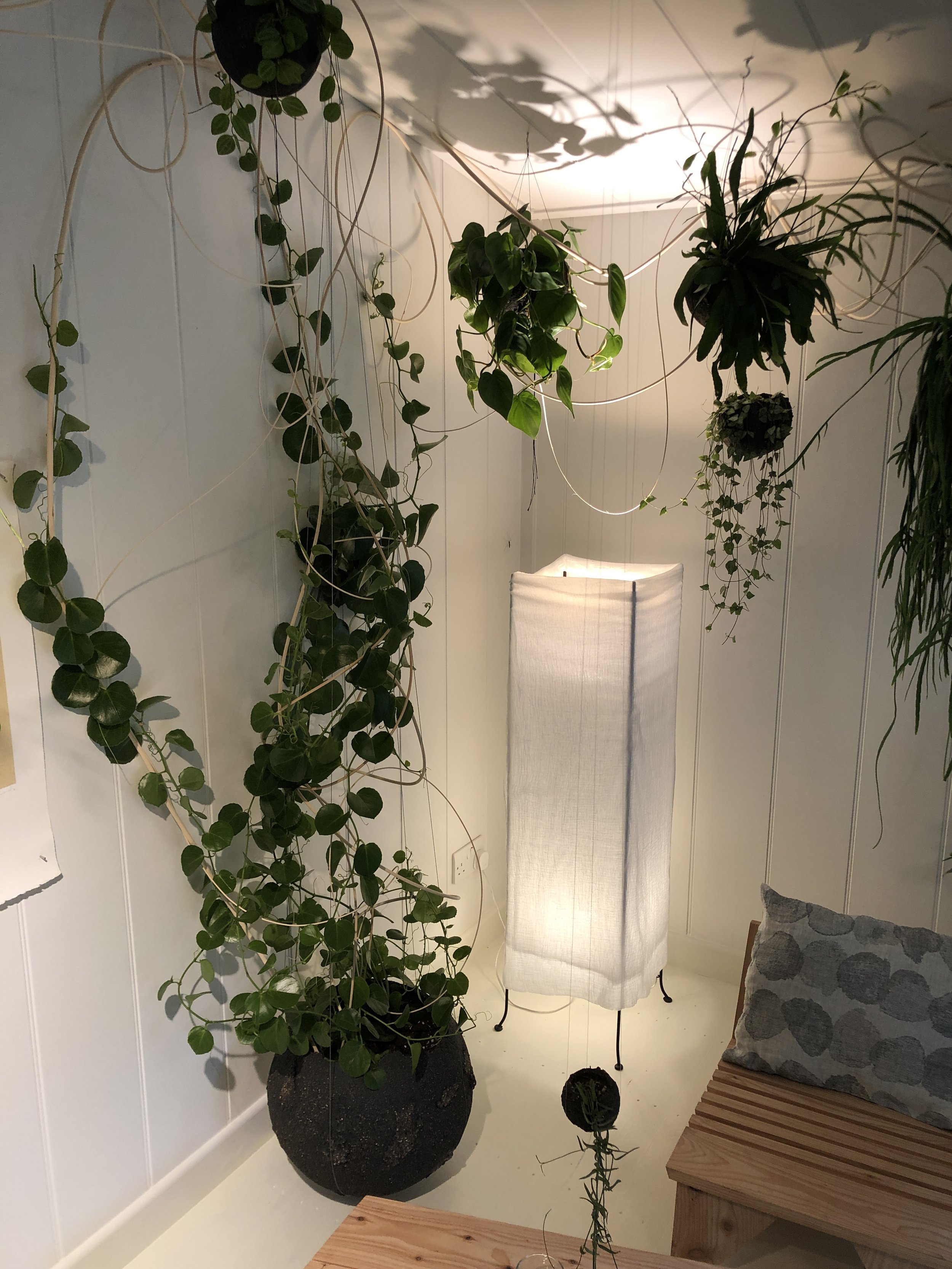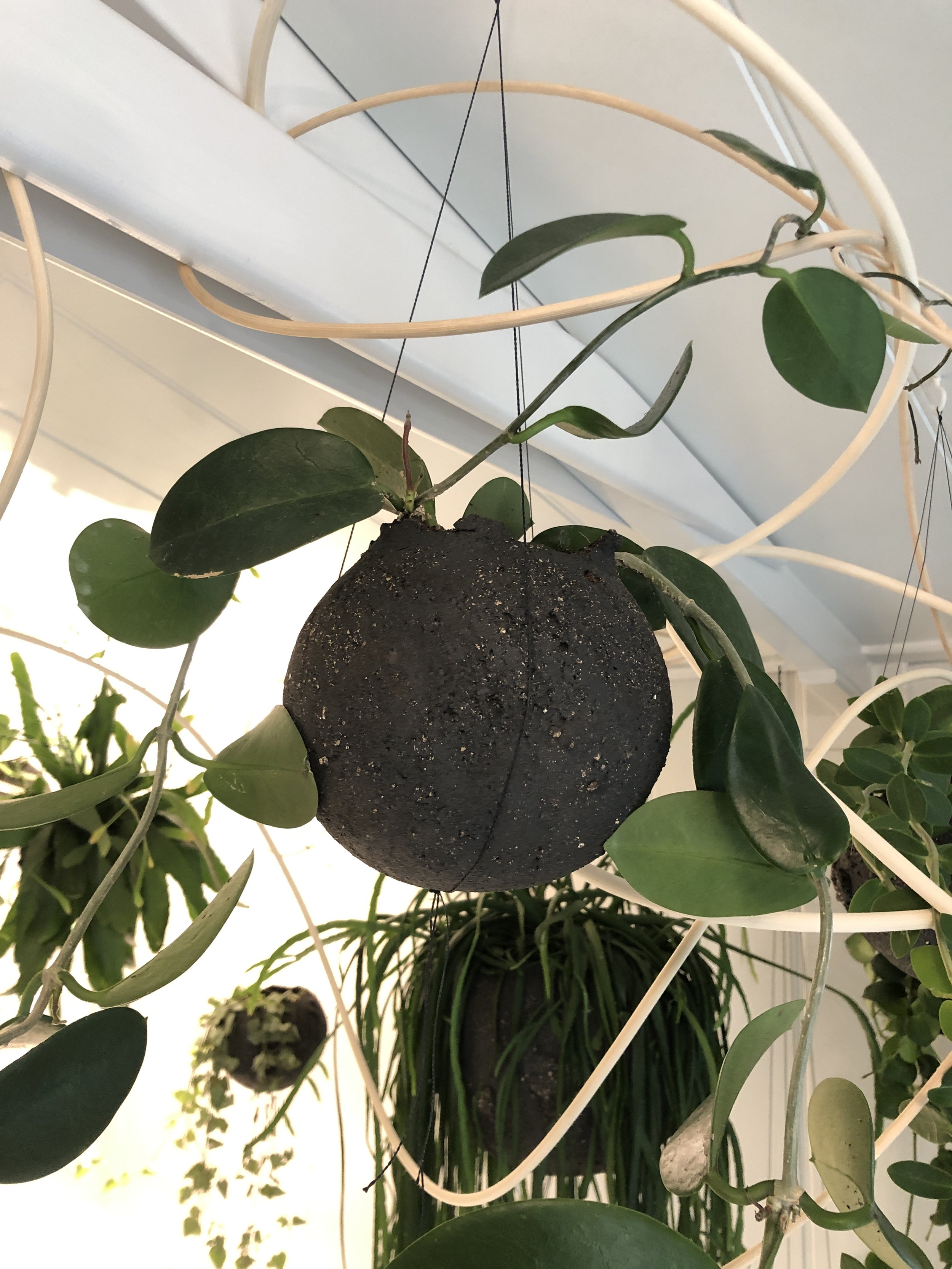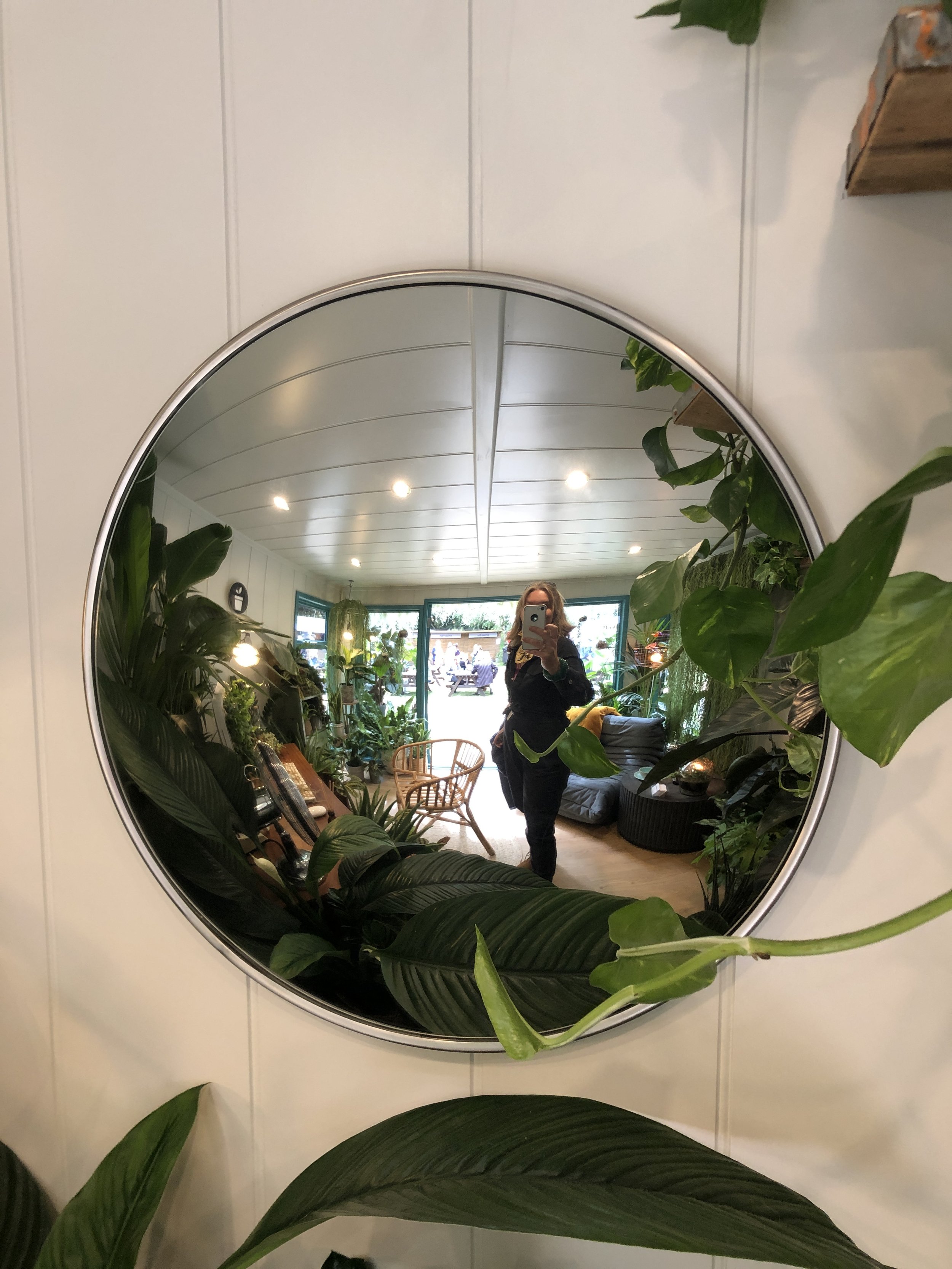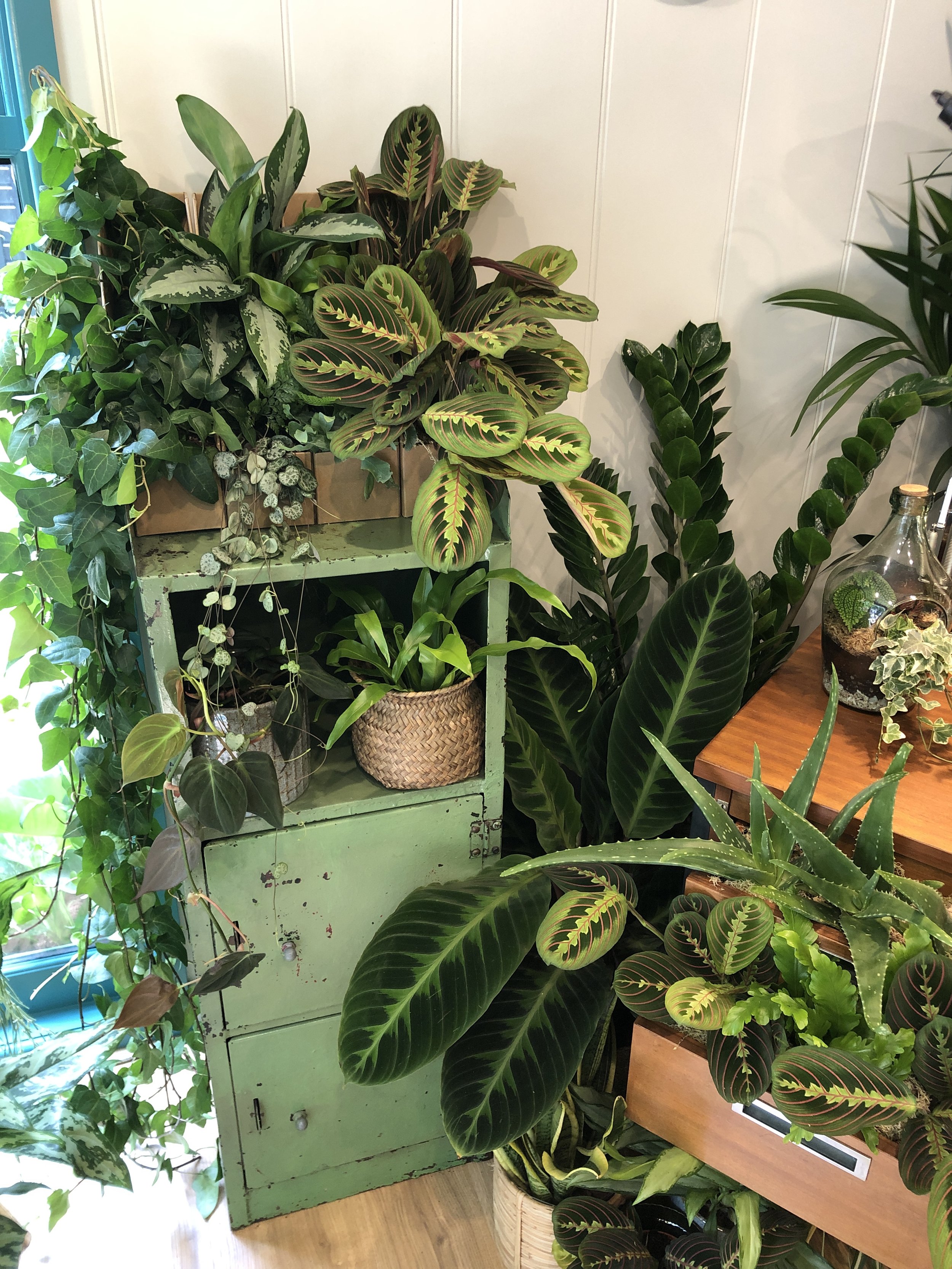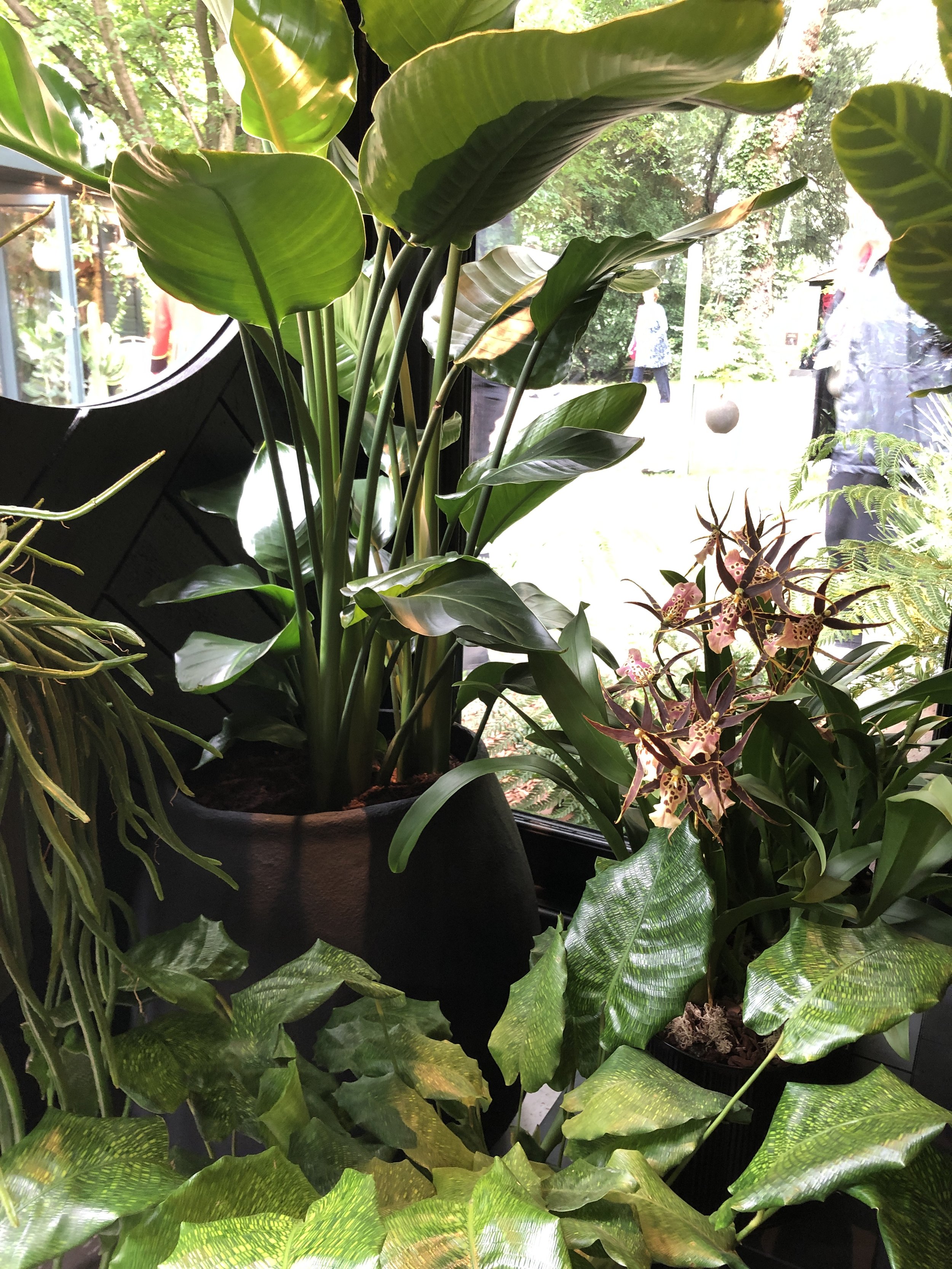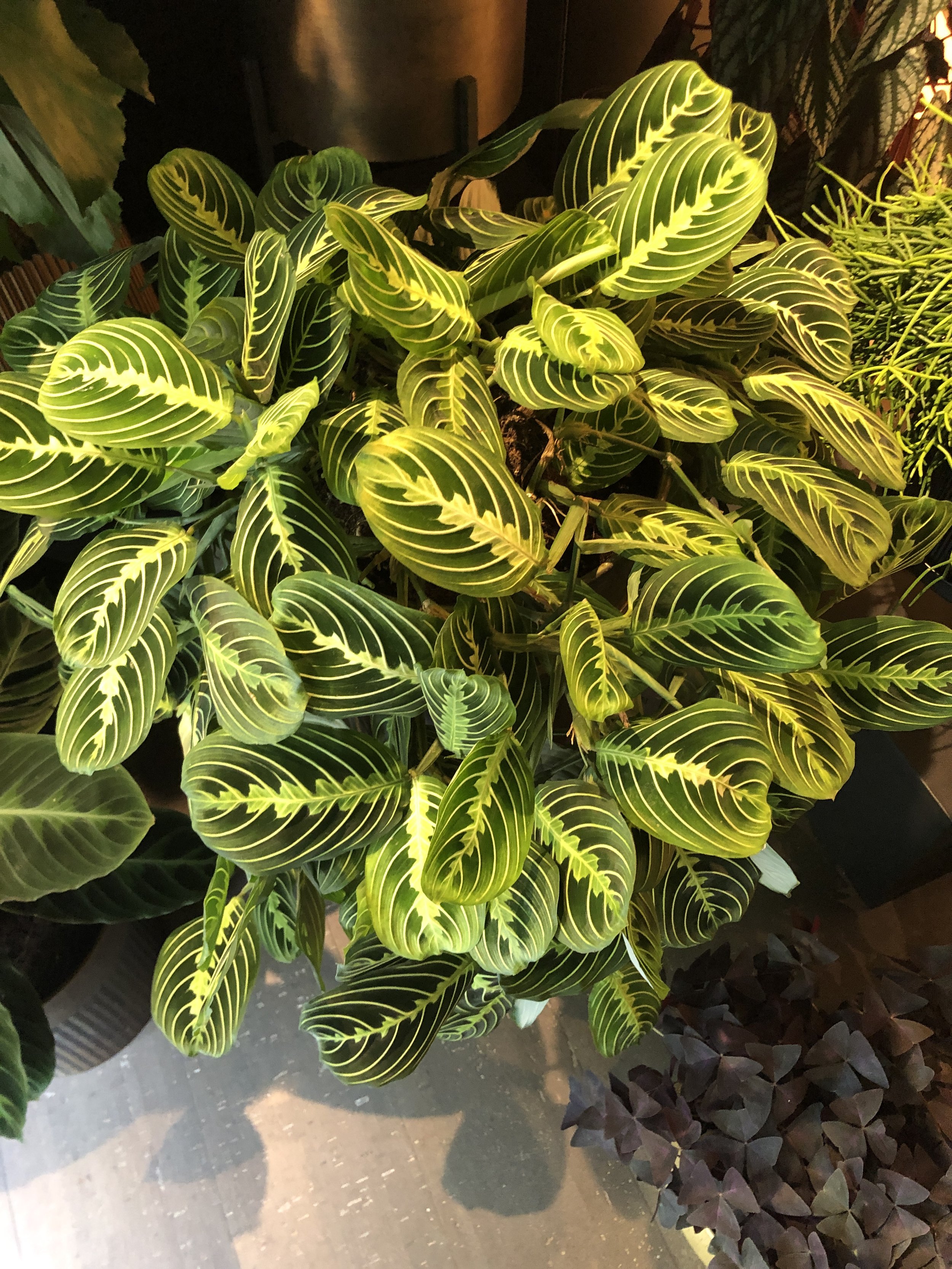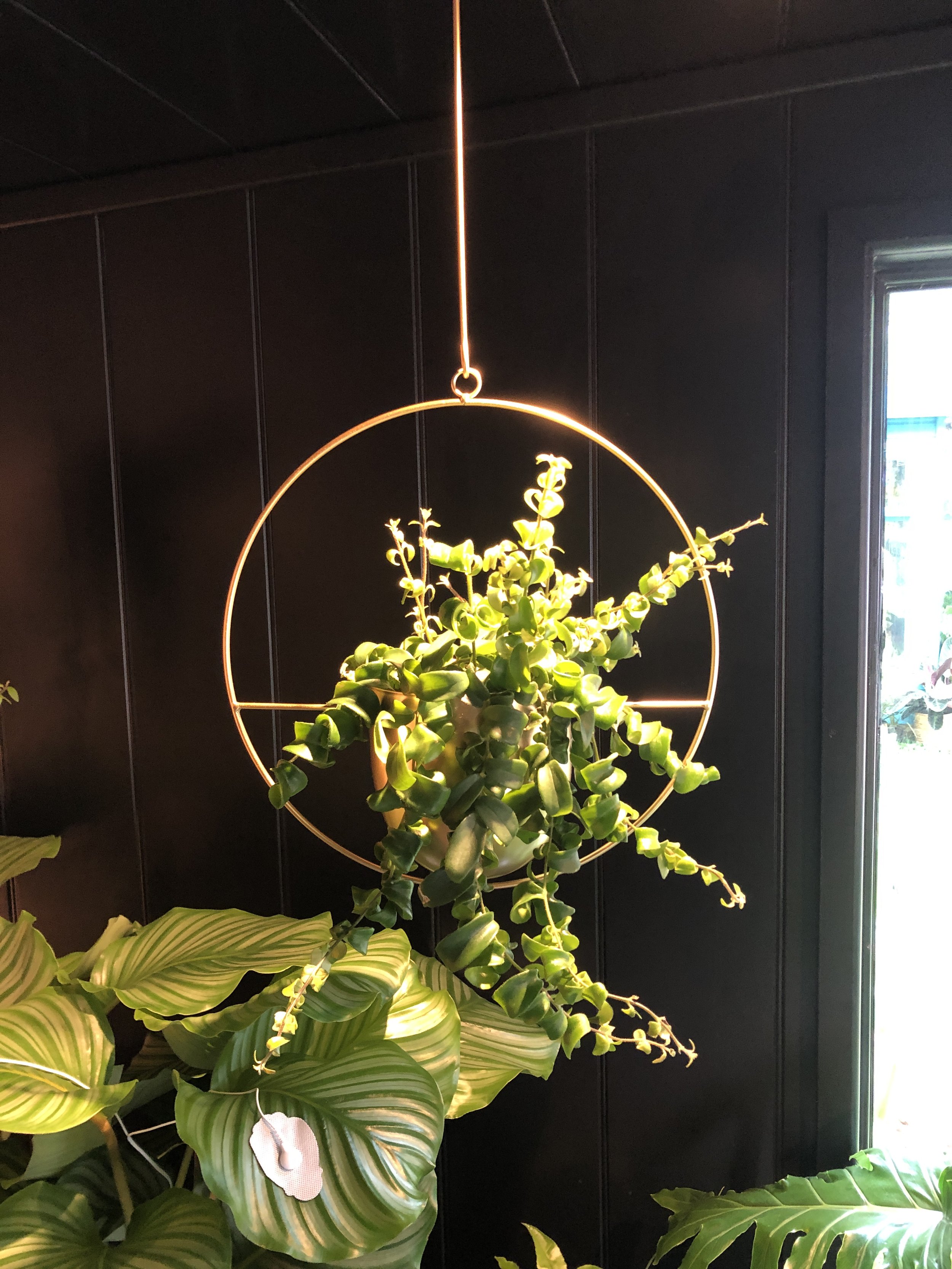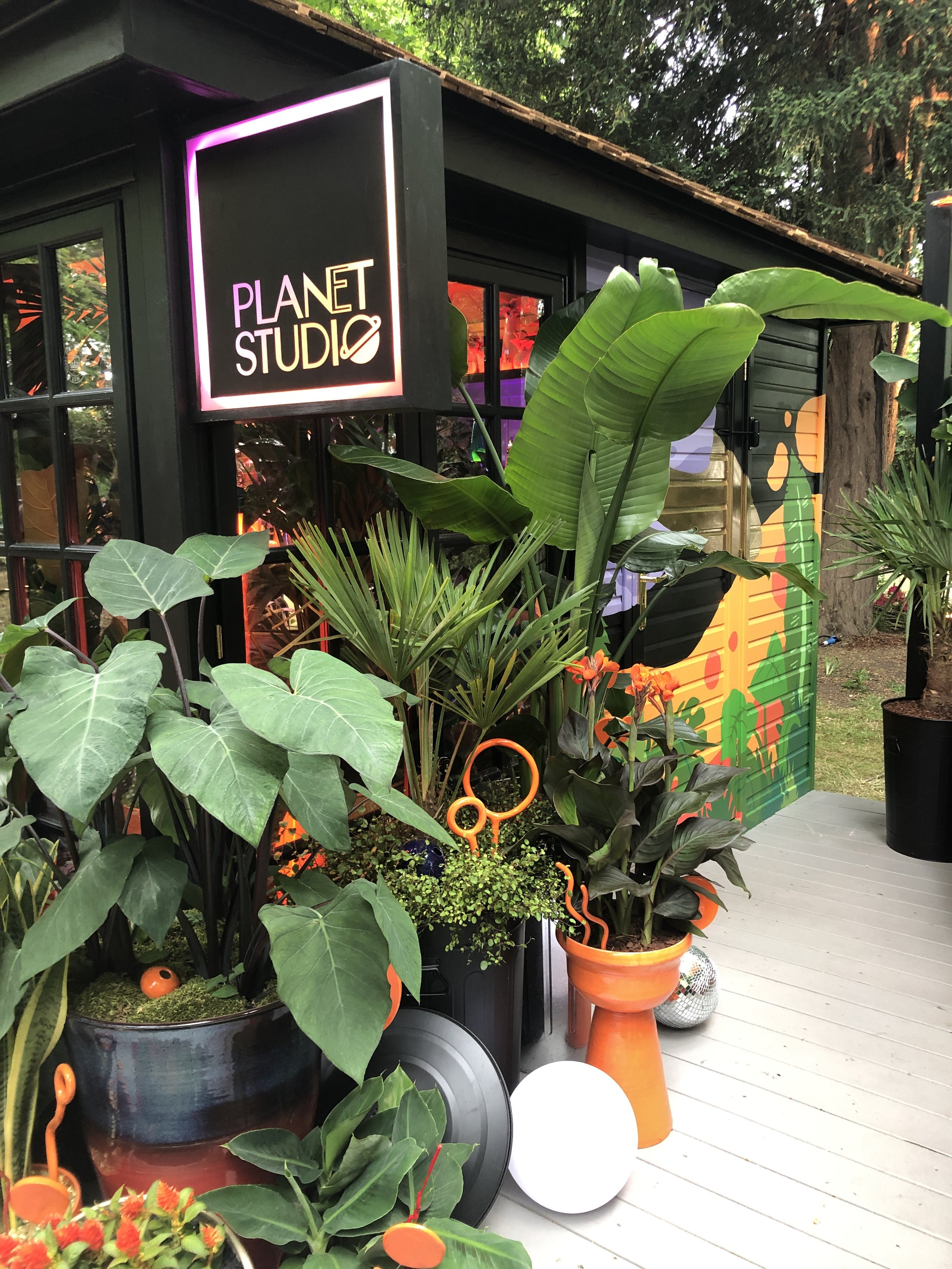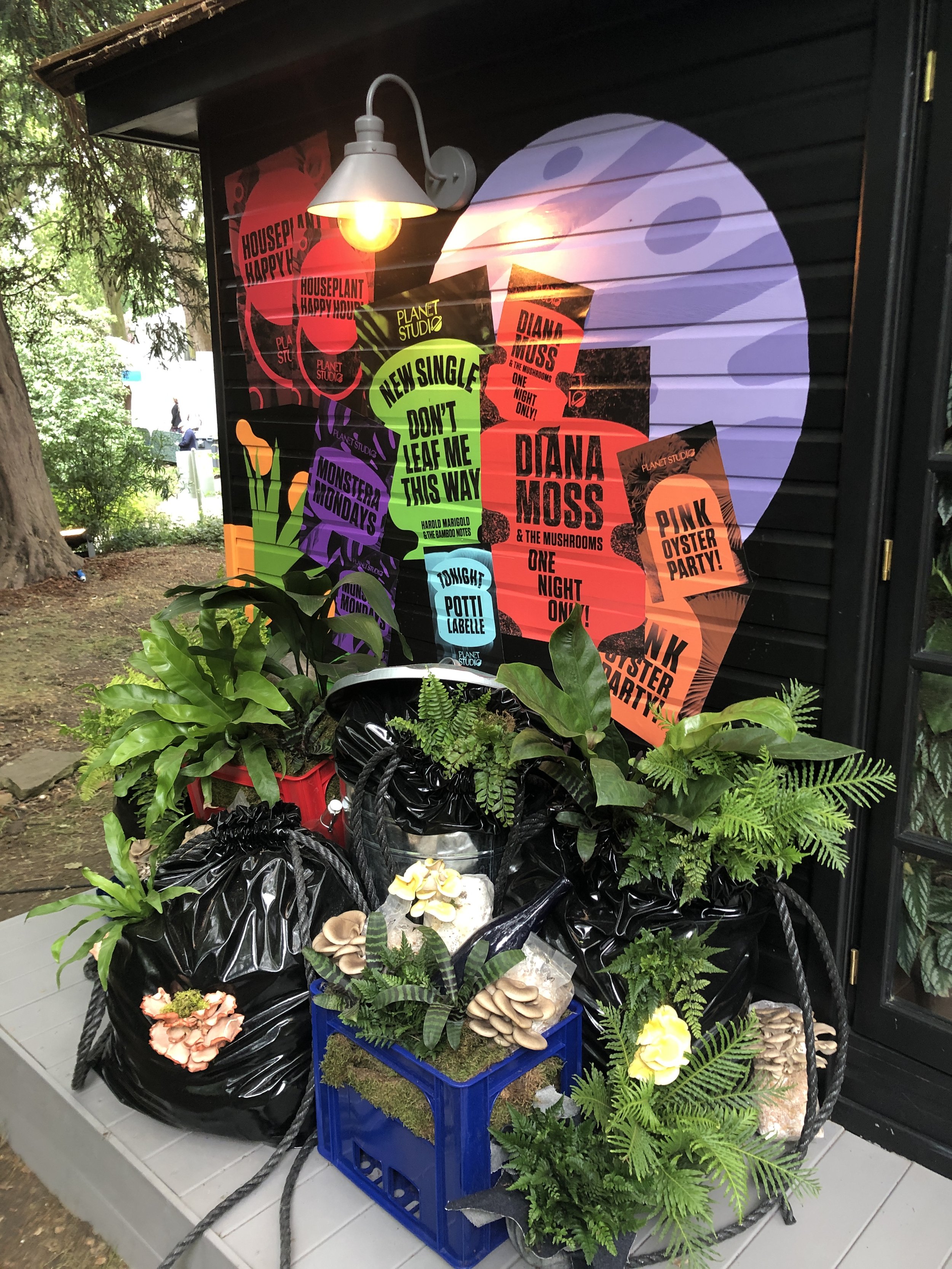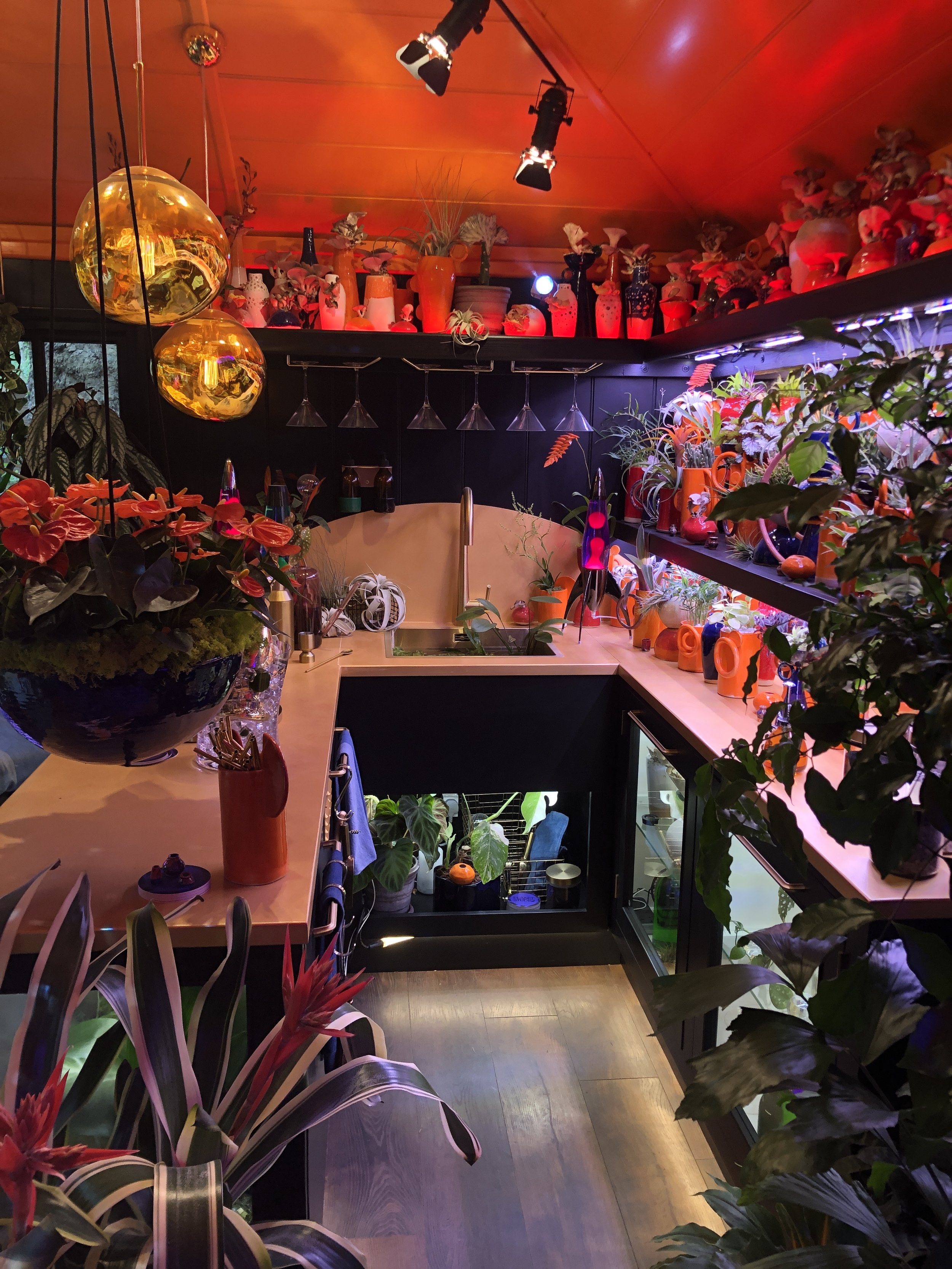Episode 224: the Chelsea flower show 2022
A gold medal-winning Houseplant Studio from @WorkshopPlant entitled The Grass is Greener Where You Water It. Photograph: Jane Perrone.
Subscribe to On The Ledge via Spotify, Apple Podcasts, Player FM, Stitcher, Overcast, RadioPublic and YouTube.
Transcript
[music]
Jane: Showstopper? I've only just started. It's On The Ledge podcast the Chelsea Flower Show edition 2022. This week's show comes from the Chelsea Flower Show where I talk to the makers of the six houseplant studios and we hear from listener Bas.
[music]
Jane: What a day I had at the Chelsea Flower Show on press day on Monday. It's been going for more than 100 years and, although it feels like I've been going for 100 years, I think I've actually been going to the show for about a dozen years now. It's been delightful in the last few years, pandemic notwithstanding, to see houseplants finally, finally getting some airtime. The houseplant studios are probably the most concentrated area of houseplantiness at the show, that's where I hung out to interview their creators. What's the concept? Well, a company called Malvern Garden Buildings, who make wooden structures to put in your garden, have sponsored this area, this category, and each building offers the chance for someone to pack it full of plants, style it any way they want. Like most garden buildings there are windows at the front and sometimes on the sides, but inside is quite a dark wooden cavern in a way, so lighting was all important. In a way many of them have the same challenges we face in our homes in terms of trying to make enough light for our plants to thrive. Obviously, this is a showcase, so the creators of the houseplant studios could do things that you probably wouldn't want to do at home, plants that would need different light levels, could sit quite happily for a week and survive and probably you couldn't do that in exactly the same way at home, but there was plenty of inspiration here for things that you could replicate at home.
As ever, I'd urge you to look at the show notes while you're listening for photos of each of the houseplant studios which will enlighten you as you listen. You can also check out my Instagram account J.L.Perrone, if you click on the Chelsea highlights you'll see all my stories from the show to further enhance your Chelsea experience. Without any further ado let’s head to our first houseplant studio.
[music]
Sarah: I'm Sarah Gerrard-Jones and I'm at The Plant Clinic at the RHS Chelsea Flower Show.
Jane: Sarah, this is so exciting. This is a day I've long looked forward to seeing your houseplant clinic, congratulations on the book.
Sarah: Thank you so much.
Jane: Guest of the show. We're sitting on these lovely wooden…
Sarah: These are reclaimed-tique, aren't they beautiful?
Jane: So nice! We're not here for the wood but it's exciting, it's nice to have good furniture also.
Sarah: These can double up as pot stands, seats or pot stands.
Jane: Yes, I'm liking that because there's nothing worse than a wobbly pot stand, there's so many plant stands that are just really inadequately strong.
Sarah: Absolutely.
Jane: We've all been there with things falling over and behind us we've got this beautiful plant wall. I'm loving the use of Chlorophytum comosum, the Spider Plant, it looks amazing in the wall.
Sarah: Doesn't it? Because you're used to probably seeing outdoor plants in a living wall but not so much the indoor tropicals that we know so well, but yes, they work great, don't they?
Jane: It really does look great.
Sarah: They're lit from above by grow lights using Soltech Solutions.
Jane: Saltech Solutions, show sponsor! It looks really, really good. Is this one of these bespoke systems for green walls?
Sarah: Yes, it is, yes, so you fill it from the top and then, basically, the water drips down to all the components, so every single plant has got access to water. It's like a wicking mat at the bottom of each. They all look great, don't they? They've been in there for about a week and so far so good.
Jane: You're hoping that people are going to come here with plant problems for you to solve?
Sarah: I hope so, I hope they're not the same ones over and over again, but yes, we're trying to educate people how to look after their houseplants better.
Jane: We can all say amen to that. Inside you've got a lovely substrate bar, that's what I'm going to call it, I don't know what you're calling it?
Sarah: It’s a soil bar, basically, they're treatments for our plants, so this is how to better keep them alive and we're talking about the substrate being very important. So we have tailor-made substrates depending on what type of plant you have. So we have an Alocasia mix and we have a Monstera mix, because I think getting the substrate right, you're 50% of the way there to keeping your plant alive.
Jane: Exactly, I think that's going to be a real shocker for some people who are not houseplant growers to see that and go: “I have to repot it in different stuff?”
Sarah: Exactly, “I can't just keep it in what the grower sent to me?”
Jane: The other thing I must remark on are these huge, huge Boston Ferns outside that must be enormously heavy. It's on a big hook.
Sarah: Well, it rained the other day, so you can imagine how heavy it is now, so I'm hoping the hooks hold up.
Jane: Well, it's putting out loads of new fronds and it looks amazing.
Sarah: It's fantastic and it was sourced by Mark who also designed this studio. He's Happy Houseplants, so he managed to get this direct from the grower. I think it was quite hard for him to find them at this size.
Jane: Yes, that is enormous. It does demonstrate how big these guys can grow, you need space and you need height to make them really work but they are absolutely beautiful.
Sarah: They are the star of the show.
Jane: They are the star of the show and behind you you've got a lovely shelf of various terrariums, I know you love terrariums.
Sarah: I absolutely love terrariums but this is the master of terrariums. We've got Ben from Worcester Terrariums here and he's also brought along his very famous terrarium, which has got 65 million views on TikTok.
Jane: Wow, that’s incredible.
Sarah: It's full of, I think you call it, microflora, the minibeasts and so you must take a look at that.
Jane: I will take a look at that.
Sarah: We're calling this the steam room. So plants that like high humidity, we advise you put them in a terrarium or in a glass cabinet or something like that to keep the humidity raised. That way you'll be able to keep these plants alive, like your classic Fittonia and things like that. We've also got some rare things in here as well and some beautiful mosses. We're basically making a spa clinic for your plants and we've got all the treatments available that you would imagine in a spa.
Jane: I absolutely love that idea, that's so perfect. Well, thank you very much for sharing this with me and good luck for the week, I hope you get lots of plant problems to solve.
Sarah: Thank you so much, nice to see you, thank you.
Jane: Sarah Gerrard-Jones, The Plant Rescuer, who's been on the show before. She teamed up with Happy Houseplants on The Plant Clinic and I'm delighted to say they won a gold medal for their work. And those ferns? Well, having looked at them more closely, they’re what we call Macho Ferns, which if you remember back to the Hilton Carter episode, those are the extra, extra huge ferns related to Boston Ferns but actually from the species Nephrolepis biserrata, so do check those out in the photographs in the show notes.
Now, onwards to the next houseplant studio. We take a few steps under the large plane trees, alive with ring-necked parakeets, yes, we have parakeets in London, to the next houseplant studio to meet Mo and Charlotte.
Mo: I’m Mo from the Botanical Archive.
Charlotte: Hi, I'm Charlotte Durrant from the Aroid Attic.
Jane: This is pretty exciting to be here in your beautiful houseplant studio. What's the concept?
Charlotte: The concept is Social Media versus Reality. Our design is set in a houseplant collector/influencer’s living room. It's full of all sorts of different rare plants and more common plants. It's got all different propagations going on, terrariums, a little greenhouse cabinet, orchids everywhere, yes, it's full.
Jane: It is full. I wish my front room looked like this, it's amazing. Mo, some of these plants are yours, you've brought your babies with you to the show.
Mo: I have.
Jane: This is the Instagram side here, tell me about this side.
Mo: We’ve got mostly Aroids I would say, if not only Aroids, we've got a little Begonia on the side there. A lot of these are my private collection, mostly things I've grown from cuttings, so thankfully managed to get them to grow quite big just in time for Chelsea. I’ve got some quite rare things here as well, so we've got Philodendron spiritus sancti, we've got a nice looking specimen of Anthurium crystallinum and then some hybrids around the place.
Jane: Will you be guarding your Spiritus sancti throughout the week?
Mo: Yes, I’ll be checking bags for scissors.
Jane: Oh gosh, I would think so too. This is important to get across, isn't it? This contrast between what we see on social media and the reality of keeping houseplants. So on this other side we've got some repotting going on, it's kind of tidy repotting but you know…
Charlotte: It's Chelsea repotting.
Jane: It's Chelsea repotting exactly. It's really good to reflect on this because I think a lot of people who perhaps are getting into the hobby are looking at Instagram are feeling a bit disappointed with their own collection.
Charlotte: Yes, I think that's the thing, isn't it? It can be quite overwhelming to see everybody's perfect rare plants and think that you have to go to that sort of level to have a houseplant collection. I think it's important to show off the more common houseplants and just how beautiful they are and how they don't look out of place next to the rare ones, they all go together really nicely and have an interest in all the different leaves.
Jane: Yes and you've got a lovely plain green Monstera deliciosa and with all those lovely spaghetti soup of aerial roots going on which… if you grow that plant you know…
Charlotte: Yes, it's a proper piece of the jungle.
Jane: Yes, exactly, that's what happens and you have to accept that you're going to have these aerial roots just climbing all over the place. Mine went under my sofa and I just couldn't get them out for a while. So, yes
Mo: It’s best to embrace it.
Jane: It is best to embrace it. Other plants we've got on this side, we've got the wonderful Oxalis triangularis, that's one of my absolute faves, any particular faves on this side Mo?
Mo: I think I'm really, really pleased with the planting up of the logs on the ceiling.
Charlotte: With all the Phalaenopsis orchids, the Moth Orchids, because they're quite easy to get hold of but up there they look so special and they look rare.
Jane: What you've done is you've avoided that very strict look of them held to a cane and instead you've got them as they would be in nature, growing epiphytically on this branch and trailing down, which makes the flowers look really different, doesn't it?
Charlotte: It does.
Mo: Absolutely, I think that's what we intended with it, to show off Epiphytes, as well.
Charlotte: Yes, show off all the different shadows that they make, they look beautiful.
Jane: Yes, they really do. As I say, the cane thing, I'm just like: “Get rid of the canes,” and it's really nice to see how that can work. Now you've got it all set up, are you hoping that it's going to have a good impact this week and you're going to get lots of people, hopefully, reassessing?
Charlotte: Hopefully, I think it would be nice for people to come in, take a seat, smell the Cambria orchids up in the ceiling as well because they smell beautiful and just feel like they could do this at home, it feels homely in here. It's not like a huge thing to start venturing into, yes.
Jane: Can I also salute you that you've got some houseplant books on display there, including my bible The Houseplant Expert, the exact edition that I had as a child, which I'm so happy to see there. You've got some Aroid Society documentation and Cactus World, yes, the old Cactus World, I was sorting out my Cactus World journals last night. It’s great to see that because I think these days sometimes people don't realise what a good resource books and societies can be.
Charlotte: Definitely, I think it's so easy to get lost on the internet Googling things, isn't it? Having the books there to look through really helps.
Jane: It's a lovely, lovely space and outside you've got more plants, I'm slightly jealous of your Hoya Krinkle 8 because that's looking amazing. I love these dish gardens too.
Charlotte: Yes, we wanted to do outside as sort of like an ode to cacti and succulents. They can go on a balcony, they can go on a sunny spot and they still look amazing, you can have a little collection of those. Not spending too much either, which is nice, and they look fantastic.
Jane: What do you think is going to be the plant that people are going to be most drawn to? Is it one of these Anthuriums?
Charlotte: I think that Anthurium there, the Velvet Red Chrystallinum, they look amazing but I think they all just go together so nicely, don't they? I think they're all so different it's hard to have a favourite.
Mo: I think the Monstera as well because that immediately draws you in when you walk into the building.
Jane: Is this the beginning of the revival of the plain green species?
Mo: Let’s hope so. I think it's underrated.
Charlotte: I hope so, yes.
Mo: I think people have almost become a little bit obsessed with the variegated Deliciosa and I think that the plain green one really has some more of an impact.
Charlotte: With the huge leaves as well, there's a leaf over there that one at the back, it’s 45 cm / 50 cm, it's massive.
Mo: I think that's what we wanted to show in some respects, it doesn't matter how rare or how kind of unusual the plan is, if it's grown well it will make an impact and I think that Monstera really shows that.
Jane: That is really, really good point. Well, it's great to see it. Also at the back, I've only just noticed your cabinet and I'm sure you'll get a lot of people going: “Oh, I've never thought of that,” but that is great. Also, can I just say, I'm loving the prop boxes as well. That's a really good thing because anyone who is into houseplants will go: “Oh yes, got lots of those,” exactly, the mysterious misty box that's got God knows what inside it, that's a really nice touch. I'm sure it will be very inspirational for lots of people to see, good luck guys, I hope you have a really great week and thank you very much for sharing your houseplant studio with me.
Charlotte: Thank you for coming to visit.
Mo: Thank you.
Jane: I think we can all relate to that studio. I just love that prop box feature, it just felt so right. Let's move away from the houseplant studios for a little while because I want to turn to talk about Chelsea Plant of the Year. Normally this goes to an outdoor bulb or a shrub, something like that, but this year it went to a succulent, so this was exciting for me. The winning plant defeated nineteen other plants on the shortlist to gain first place and the plant in question is an intergeneric hybrid, yes that's kind of exciting. It's a cross between an Aeonium and a Sempervivum, so it has the name x Semponium, see what they did there, and the cultivar name is Destiny. I'll put a picture of this in the show notes but it's a big meaty beast of a succulent in that rosette form that we see in both Aeoniums and Sempervivums. Unfortunately, I don't think it's as cold hardy as Sempervivums, I think you'd have to treat it more like a regular Aeonium but, boy, does it have some pulling power. It's very beautiful, dark purple spoon-shaped leaves in a rosette. They're giving me dinosaur skin vibes and this was bred by Surreal Succulents, which is a cornwall-based succulent nursery set up in the last few years that's done tremendous work and it was really exciting to see them win in this category, so do go and check that plant out in the show notes. Staying in the county of Cornwall, the next houseplant studio I visited was created by The Planted House in Penzance.
Antonia: I'm Antonia and I am the owner of the planted house in Penzance in Cornwall.
Jane: Well, I'm sorry to say that I haven't yet been down to Cornwall to visit you but I would love to. For the moment, I can enjoy this beautiful houseplant studio. It feels very light and airy in here which is a good thing, with all these beautiful hanging plants, what's the overarching concept?
Antonia: Well, the intention really was to create a display where plants are able to show off themselves in a space where they're not crowded, they're not… light, airy, delicate, I love hanging plants personally, we wanted to create space between plants so they could be appreciated for themselves. But also to show how you can have a living space, which isn't rammed with pots everywhere, we have at home in the shop, we're quite full and quite crowded. Having spoken to so many customers over the last couple of years, the feeling we get is that many people are trying to buy and buy and buy plants, they just want more and more and more plants, they always want to squeeze in another one. We're now saying to people: “Pull back a bit, have less and appreciate the ones you've got, give them space to breathe.”
Jane: I'm loving that message, I think I totally embrace that and I think there will be lots of people who are receptive to hearing that. I'm loving the way that these plants are hanging, tell me about what they're hanging in?
Antonia: So they're hanging in handmade planters, which we sell in the shop. We came across a potter in north London three years ago who was actually making these pots but in smooth clay with glazed rims. So we had them in the shop, I then came across this amazing chunky, gritty clay on a very short pottery course that I went on and I tentatively approached her: “Would you mind possibly trying this clay because this is like soil,” and we wanted to create that sort of ball of soil effect. She was willing and she discovered she really enjoyed working with it. We then realised that these were selling more than the smoother ones. So for Chelsea, obviously, we commissioned her to do a whole load and it’s become a massive part of our theme.
Jane: Yes, I really love these. The way that you've got the understated black wire hanging from the pot, suspended on this black wire, which is really nice, it's really strong but it just doesn't get in the way of the scene.
Antonia: Well that was the Newline Chandlery who helped us with that one, we went down looking for something super strong and super minimal to hang them with. Up to this point we've made black wire rope hangers with ferrules, which is a different approach in itself. These are just really minimal and delicate, so they appear to float and that was the idea. It's not about the hangers really, it's about the pots and the plants.
Jane: You've also got this amazing network of… I'm not sure what this is, some kind of natural material, wood, but it's bent in all kinds of funny shapes.
Antonia: It's Rattan, it's harvested in Asia, it's a form of Liana Vine in the jungles, jungles are full of it, it uses other plants to support itself. It's used for making furniture and baskets. Rattan furniture goes very well with houseplants as we know. So we've decided to use it as a plant support where it can be. I love its evenness, I love its flex, I love the way it can whirl around and have a signature of its own, a life force of its own. We've sort of reversed its role, I guess, from what it does in the jungle.
Jane: I just love the way you've used this as a plant support and also just as a way of joining together, in a kind of subtle way, all of the different plants in here. You've got lots of lovely plants in here, I'm immediately drawn to the Lepismium which is one of my faves, absolutely beautiful plants.
Antonia: That's my favourite the Laurocerasus.
Jane: Which species is that?
Antonia: That’s the Rotundifolia.
Jane: Yes, that's a really underrated plant.
Antonia: It is.
Jane: I wrote a column about it in the RHS magazine and then I got told off because nobody could get hold of one! I don't know whether there's more available now.
Antonia: They’re a little bit more available. I tracked one down about three years ago, I'd first seen it at Burford Garden Company in their cafe, it was completely taking over their ceiling and I think they've taken it down now. I actually got them to root around deep down in this vessel to find an old plant label so I knew what it was. Then I actually found one with the House of Plants in Sussex, they sent me a tiny one in the post but now they're more available.
Jane: It's a beautiful plant and quite really quite easy.
Antonia: Yes, you can virtually ignore them, they're holding a lot of water in their leaves because they're semi-succulent. They will just go for it and they'll do growth spurts, so they'll do a foot in a couple of weeks and then they'll just stop and go to sleep.
Jane: You've got a lovely Ceropegia linearis which is so subtle, I just think that's adorable, coming down over the middle of this low table, you've got this tiny, tiny pot.
Antonia: I love these.
Jane: It is a beautiful leaf and it looks really stunning there, especially because it just looks like it's suspended in space, which is wonderful. What are you hoping that people will get out of visiting here, hopefully that they'll think again about their collection?
Antonia: I think the message from me is to stop gathering and hoarding and just trying to squeeze in another plant. The love of houseplants has exploded and there's a lot of people just collecting as much as they can, but you can, in the end, stop seeing all the individual plants that you've got. I speak from my own experience, I've got a house that looks like a hedge! The shop can get very full and it can be overwhelming for our customers sometimes. We have to pull back and creating space in between is really important I think.
Jane: Well, I think that's a wonderful message and I really hope your week is successful and that lots of people come and visit. I'm also very envious of your extremely long Hoya linearis, I thought mine was long but that's like two meters long, that's absolutely stunning.
Antonia: I always think it's like hair.
Jane: I mean if you're feeling stressed you can just literally gently rub your hand down a Hoya linearis and you feel better don't you?
Antonia: I do love these Hoyas.
Jane: Yes, don’t get me started, the Hoyas are great, absolutely great.
Antonia: You keep playing, I just couldn’t stop fiddling in here, you have to learn when to stop.
Jane: Exactly, it's a really beautiful environment and I love the space and the air that you've got in here, it feels really good, so thank you very much.
Antonia: I didn't mention my husband who made the furniture.
Jane: Oh your husband made the furniture?
Antonia: Well, we made some plant boxes for a client in Penzance, he was doing some outdoor landscaping for them and he made them these fabulous plant boxes that go on a very high wall and these were from the offcuts.
Jane: They're perfect.
Antonia: Rather than being round he realised he had just the right amount of wood to do that, which worked out.
Jane: That’s amazing, that’s beautiful. Well, I hope the rest of your week goes well.
Antonia: Thank you.
Jane: So far so good on the weather, I thought we were going to be rained on.
Antonia: Not yet, I think it’s coming.
Jane: Not yet, it may be coming.
Antonia: It’s nice and humid though.
Jane: Yes, that is true, perfect for houseplants.
[music]
Jane: Of course we ended up talking about the weather, we are British after all. Now it's time for Meet the Listener.
Bas: Hi Jane, this is Bas from the Netherlands.
Jane: When did you get into houseplants and why?
Bas: I got into houseplants around September 2019, when I was researching how to repot a ZZ Plant. It was growing already at the student housing that I moved into back in 2006 and it moved out with me in 2010. So it has been growing in the nursery pot since then and it was in dire need and basically breaking out of it already. However, plants have been part of me and my family, with my mum and my grandmother being the people with the greenest thumbs, I would say. I'm actually very happy to be growing a division of an heirloom Sansevieria from my grandmother and, hopefully, I will get my hands on a cutting of the Begonia Corallina de Lucerna, Angel Wing Begonia, which my mum is growing and it's already been propagated many times and it's growing at my sister's house currently as well as at many other people's houses. So I will say that even though my gateway into the plant business was around the September 2019, they've been part of my life for a long time.
Jane: What's the latest addition to your houseplant collection?
Bas: The latest addition to my plant collection is a couple of very commercially rare Sansevieria, namely the Bantel's Sensation and variegated Whale Fin. I am very stoked that I finally got my hands on both of these and currently they are in need of a pot with new substrate because they're still sitting in the packaging. I am being a little bit lazy to remove them from but I'm sure they're fine.
Jane: Ccomplete the sentence: “I love my houseplants because…”
Bas: I love houseplants because they really brighten up my space and I really like to be immersed in green. I'm a biologist at heart, even though I work as a flight attendant, but it makes coming home so nice and really relaxing.
Jane: Who is your houseplant hero?
Bas: I want to say my houseplant hero is Summer Rayne Oakes because she made a video about repotting a giant ZZ Plant and this is the video I watched prior to getting stuck in myself. She was basically my gateway person, watching her videos just dropped me into a giant rabbit hole of plant videos and plant content on the internet and I've been hooked ever since.
Jane: Name your plantagonist, the plant you simply cannot get along with.
Bas: As for my plantagonist, that is a difficult question at the moment. I am really struggling with growing some Heartleaf Philodendron, there's two specimens in my home right now and one of them is seemingly under constant attack of thrips. Did I mention I'm a lazy plant parent? Yes, so I haven't been very diligent at removing the thrips and they just seem to keep attacking it and I feel kind of at a loss, but I roll with the punches and I keep going. It seems that the plant is keeping going as well, so who knows what the outcome will be, hopefully my home will not be swallowed by the thrips!
Jane: Thanks Bas and I hope that the thrips decide to decamp elsewhere for you. If you'd like to put your name forward for Meet the Listener we'd be delighted to have you, just email OnTheLedgepodcast@gmail.com and instructions for taking part - don't worry, they're very simple - will be winging their way to you.
Now it's time for some thank yous. Kit, Jennifer and Maria all became Ledge-ends in the last few days. I received two excellent reviews, one from Argolub in the US and DebsW in the UK, you have no idea how much these things lift my spirits, so thank you to you all.
It's time to visit another houseplant studio and this one… Well, let's just say I wish my office looked as good as this.
[music]
Kirsty: Hi, I'm Kirsty, I'm a team member at The Plant Workshop.
David: I'm David, I'm the owner of The Plant Workshop.
Jane: Here we are in this wonderful work from home office. I wish my office looked like this, maybe not with the moss under the keyboard, that's the only thing I'm not on board with. It's a beautiful space, tell me about what the concept was.
David: So the concept was a work from home space. We started our business a couple of years ago in lockdown, lots of people were working from home and trying to really appreciate what they had at home and we were delivering plants around the northeast of England and North Yorkshire. So we decided to go back home, bring everything back to basics, with lots of easy care plants which are great for wellness but accessible for everybody really who, regardless of their space or budget, would be able to benefit from.
Kirsty: It works in terms of boosting energy, boosting productivity, making you feel good but also having an option to have an easy care plant if you don't have as much time to care for one with your busy schedule.
Jane: Yes, that's the thing, isn't it? I think lots of people have acquired lots of houseplants during lockdown and we need to get ones that aren't going to demand too much of us. You've got lots of things here that are really, really easy, what would you say is one of your all-time favourite “put it in the corner and don't worry too much about it” plants? Any tips?
David: Tips, well we've got the very well-known Sansevieria or Snake Plant, which is fantastic for very low light up to some bright light. That one you can put in a corner, forget about, you don't need to water it that often but they are really easy care.
Jane: I know this isn't quite so easy but this lovely Crocodile Fern next door, that's enormous!
Kirsty: It is enormous, this is actually a semi-hydro as well, so it makes it a little bit easier to care for because it has a gauge telling you when it needs water. In that aspect, it is easier than if you just had it…
Jane: I love that, I love a gauge.
David: It makes life so much easier.
Jane: Exactly. Your business started during lockdown, that must have been a rollercoaster?
David: Yes, it was difficult, it was never planned that way. We had a shop that was going to open and then we couldn't open it and we couldn't get any building supplies and things, so we ended up with lots of brown bags and we had a summer house in the garden and we started to sell our products online through social media. We just had that huge amount of support from lots of customers and, yes, it was quite a ride.
Jane: I can imagine and now things have settled down, how has that changed as we get back to new normal?
David: Yes, I think lots of people now are buying more plants to green up their space because we've talked about that wellness aspect, the cleaner air and I think a lot of the customers are really passionate for those smaller businesses, I think that's really, really important. They're probably shopping less in those bigger outlets and coming to more specialist people who really know what they're talking about.
Jane: Yes, that's great, that's the reason to go to a specialist plant shop is for that personal touch. Do you have customers who have just been becoming frequent flyers as it were? I bet you've got some customers who just keep coming back for more?
Kirsty: Yes, we definitely do, it's great to see people coming back. We also try and get different plants in, we change up what we have and get new stuff in.
Jane: I have to say I'm loving the curtain of Hoya linearis that you've got here. I hope you don't take this as an insult because it really isn't one, but it's slightly reminding me of a page in my bible, the Dr. Hessayon, The House Plant Expert, where he recommends using plants as a room divider. It looks so good because you've got these five pots all cascading down, that Hoya linearis is ridiculously long.
Kirsty: It’s so long.
Jane: It’s actually pooled on the floor there, that’s amazing.
David: It's 2.5 metres long.
Jane: Wow, okay, I'm now feeling very inadequate for my Hoya linearis, which is a mere metre-and-a-half, very impressive.
David: It really softens the space though, doesn't it?
Jane: It does.
David: We’ve overlapped it over the window, so it gives you that extra shade.
Jane: When you're talking about an easy care plant, I think that is very easy, once you know what it wants, it’s really easy.
Kirsty: Absolutely, yes.
David: We had the conversation earlier today, actually, about Hoyas that they don't get as much press as what we had hoped really. Hoyas are so easily cared, we should definitely champion Hoyas.
Jane: Oh definitely, well I've done several episodes, so I am definitely a Hoya champion, for sure.
David: Good.
Jane: You put this together in quite a short amount of time, didn't you?
David: Yes.
Jane: I think you had, what was it, two weeks? Wow, how was that?
David: Stressful.
Kirsty: It's been very hectic, we were the late comers but we, obviously, had to jump at the opportunity to come and exhibit at Chelsea. We work really well as a team and we are very much on the same wavelength, so we were able to bring our ideas together and come up with this.
Jane: Another one of my absolute favourite things is this lovely fish eye mirror, loving that.
David: Everybody loves a fish eye mirror.
Jane: It's really good, there's something about it that's just setting off the rest of the room really brilliantly, so I'm going to take lots of pictures and use them in my show notes, so hopefully people will be looking at that as they hear this and it's incredible what you've created in such a short frame of time, so well done.
Kirsty: Thank you.
David: Thanks so much.
Jane: As you know, if you've listened to my Chelsea coverage before, the show on press day is packed not only with journalists but with celebrities. Now, I'm not generally a big follower of many celebrities, I did see Dame Judi Dench at the show, which was an honour because I think she's a fantastic actress. Most of the time I'm not really sure who anybody is, but this was the very first time that an interview for On The Ledge has been sort of gatecrashed by a celebrity. It's towards the end of the interview and you don't get to hear who it is, but I'll reveal all afterwards and that explains why we go a little bit off track at the end as I chat about the Botanical Rhapsody houseplant studio.
Mak: Hi, I'm Mak Gilchrist and I'm the creative director of the Edible Bus Stop.
Jane: In the background we've got this beautiful music. This isn't just lift music, this is a significant form of music, can you tell us what's going on here?
Mak: Well, essentially, we're utilising a process which is known as biosonification, which is a technology whereby you can read the tiny microfluctuations in a plant by attaching these electrodes to the leaves. What you're hearing right now is the music of three plants.
Jane: That's blowing my mind.
Mak: It does, that’s why I always leave a little bit of a gap there, it’s amazing.
Jane: That is amazing. Presumably reaching out and touching one of these leaves, would that elicit a response from the plant?
Mak: Absolutely. It depends on how they're feeling, by the way, because anything living has its moments, it's more reactive, it's feeling calmer, it's feeling stressed. So if I touch it now let's see what happens…
Jane: It's going a little bit more high pitched there, it's changing slightly, yes. This beautiful - I suppose we've probably got to call it Goeppertia now although everyone knows it as Calathea - velvety leaves, which are very tactile anyway.
Mak: Well, that's the idea, we wanted people to feel free to touch the plants. So that's the aim here, while you're doing this… really, this installation is all about how nature is constantly interacting with us and how we're all connected. So plants react to their environment on a constant basis in real time, by utilising biosonification, we can actually reveal the otherwise hidden communications that are going on, the otherwise inaudible communications that are going on and how, by piercing that veil of perception, you can enter into a plant world and understand that everything we do as humans, they're affected by and they're responding to us. So that sort of biophilic quality of how they're making us feel calmer, reducing our cortisol, all of those things that they do for us, hopefully, here you can access that by having this audible reaction that's going on around you.
Jane: It's absolutely lovely, it's bringing to life something that we know is there, we kind of know that plants are reacting to their environment but actually being able to hear it is really quite powerful. We know plants are sending out messages and now we can hear the messages, which is really cool. I guess it's teaching people to really observe and look at their plants because they are trying to communicate with us all the time, it’s amazing.
Mak: Yes, they're also communicating to our subconscious selves. So this is how, as I mentioned before, with biophilia, it's now being shown it doesn't just help your mental health and your emotional health, they have a physical effect on us. They lower our blood pressure, they help you heal quicker after an operation if you're around plants, they help you concentrate, so there's all sorts of levels that plants are working and they're cleaning our air. What they're doing for us is extraordinary and they don't ask for much in return, just us to stop killing them with pollution etc.
Jane: Yes, so true. I'm just loving the way this is displayed, it's a very beautiful display of houseplants. One of my favourites is I think that's an Aeschynanthus in this beautiful brass hanger, spotlighted. There’s something very mysterious that draws you in looking at that, I can't quite explain why.
Mak: I'm really glad you say that and that's one of the reasons why we've chosen totally black walls and ceiling is that we wanted the plants to really pop out. When you spotlight them like that, you can really see their form and their elegance and, yes, it's quite fabulous, it looks like it's having a good time, doesn’t it? It knows it's having its moment.
Jane: Yes, in the spotlight. I'm also glad that you've put sensors on this beautiful Calathea orbifolia, let's admit it that it's one of the harder houseplants to keep alive, but maybe if you had this set up you'd be more aware of when things were going wrong. It's an absolutely gorgeous plant with these huge, huge striped leaves and it's such a star of the show. We're just having a little feel of these Calathea orbifolia leaves and it is changing the music. Could you have this set so that you were playing different instruments? Have you chosen the instrument yourself?
Mak: Absolutely, yes, our sound artist has chosen the instrument. The way he talks about it is, essentially, what the computer will pick up with these microfluctuations, he then applies notes to and he describes it: “I give the plant fingers to hit a keyboard with,” I love that idea because it's actually quite difficult to explain, he can get quite techy about it. We're just giving the plants the tools to be able to talk to us and sing to us in this particular case. Yes, you could make them sound like banjos if you wanted to.
Jane: I was going to say, electric guitars, the world is your oyster, you could have any kind of sound coming out here. Well, it's a really dramatic display and I really hope that people come in here and sample it out and, as you say, nice to be able to be given an invitation to touch leaves because I'm often feeling a little bit naughty for touching leaves of plants when I'm going around and giving them a bit of a stroke. I think that's part of the enjoyment and the biophilia is actually being able to touch and experience different leaf textures, for me anyway, is a really powerful thing. It's lovely in here and I have to say, this huge Maranta Lemon Lime here on a stand is blowing me away because it's enormous, I've never seen one that big. I love that plant, that's my star in terms of plants in here but you've got a lovely selection of plants and beautifully potted as well, I don't know where your pots are from?
Mak: Various wonderful pot suppliers but we've gone for quite a lot of Scandinavian. As you can tell with our screen here at the back, which is to look like a Japanese shutter screen, which is lit with LED dynamic lighting. So that lighting changes colour and intensity throughout the day to mimic the sun, to key in with your circadian rhythm. It's another element in this studio to help people calm and feel at ease. What happens eventually… These lights, by the way, are all grow lights, so the plants have since they have been in here, you'll see here with this system, that it started to grow, they're responding straight away.
Jane: Awesome, well it's absolutely stunning. I feel like I just want to keep touching leaves. It’s fine, it’s fine, you can have a leaf stroke, why not.
Woody: I feel my hand buzzing.
Jane: There you go, it’s powerful stuff, it’s powerful stuff. Well, thank you very much for showing me around.
Mak: My pleasure, do come again.
Jane: I think I just want to just hang out in here and enjoy the beautiful music.
Mak: Thanks a lot for coming.
Jane: The person who came in during that interview and started stroking a Calathea leaf was a Woody Cook, I don't know if you've heard of him, but he is the son of Zoë Ball and Norman Cook, grandson of the legend that is Johnny Ball. If you still don't know who I'm talking about, have a Google, but anyway it put me off my stride a bit. He was basically doing some DJ’ing for the press call accompanied by the music of the plants, so he came in to have a little look around, hence the interview drew to a close. I should have just shoved the microphone in his face and asked him some questions but I wasn't that good of a reporter at that point and, you know me, I'm kind of more interested in the plants. Now, the final studio actually won the Best Houseplant Studio category. If you were looking for somewhere fun to hang out at Chelsea, I think this studio definitely won out.
James: Hi, I'm James Whiting or PlantsByThere on Instagram and I'm a houseplant fanatic and stylist. I've designed Planet Studio for Malvern Garden Buildings at this year's Chelsea Flower Show.
Jane: I've just been totally distracted, James, by the rotating Pilea on the floor, which I absolutely love the fact that you've got this on a little turntable going round, that's an underrated plant. I don't know where to start with this because this is a visual treat for the eyes, tell me about the concept.
James: It’s aimed at people who might have a garden room, who miss the nightlife but don't want to travel into the city for a night out, so they invite all their friends to their garden to experience a Studio 54 inspired bar and club space. It's a mix of retro, futuristic decor and 70s vibes, all those retro houseplants we love, Spider Plants and Scheffleras mixed with unusual alien looking specimens.
Jane: This is so cool, I love the orange theme, you've got this amazing ceramic selection behind the bar lit up by mirrors, which is just so clever. We've got to talk about the fungi in the room, tell me about the shelf full of mushrooms.
James: The Oyster Mushrooms are grown by Caley Brothers and I actually met them at last year's Chelsea show. They were on the RHS Garden with Arit and they were drawn to our display last year with our pink macrame and our neon lights and said they “found their people”. So we really wanted to work together and Oyster Mushrooms are one of those things that are so beautiful but people are a bit afraid of them or don't know how to grow them and they're edible as well, so it's that things that are beautiful that will also have a use in your home, I think people are paying a lot more attention to mushrooms, they're just fascinating.
Jane: They are totally fascinating and you just pointed out to me that in the beam of the spotlight, we can actually see a load of spores being released by these mushrooms, which is pretty awesome. I've just realised that there's a rotating Snake Plant as well, that's also giving me life.
James: Sansevieria on the podium dancing, it's that classic 70s houseplant everyone knows and loves, or sometimes hates, it depends on your view on them.
Jane: Oh, no, I love, I love.
James: Illuminated by some lava style projections and it's just all about energy and life and Studio 54 was a real mix of people, it was so diverse and the fashion and people from all walks of life could be there and I just wanted to do that with houseplants, a really diverse range of houseplants.
Jane: Yes, I think you're right there's a lot of houseplants that perhaps are so common or have been around for so long that we don't really rate them among them being, of course, the Snake Plant. You've got some lovely Tradescantia there as well. Just putting a Tradescantia in a really interesting bright orange vase-shaped pot, it just takes it to a different place, doesn't it?
James: Completely, all the pots have been handmade by Adam Johnson, who was on the Great Pottery Throwdown during the first lockdown, so that's how we connected through Instagram, it's been a lot of Instagram conversations going on with my collaborators on this. He made every single plant pot in the building inside and out all by hand. So, yes, it's been a real operation to get it all to come together for Chelsea.
Jane: Yes, wow.
James: It just shows that you can take a staple houseplant that may be overlooked and give it a new lease of life and show it off in a different way. It's all about pairing plants with the right containers and the right vessels to enhance them and show off their beauty.
Jane: Is there a favourite of yours here in this studio, can you pick a favourite child?
James: It’s so, so difficult.
Jane: Is this a large Kentia Palm behind me? That’s pretty cool.
James: Yes, Kew Gardens Palm House was one of the first places I visited when I moved to London and it was always one of those places I'd seen on TV and I wanted to get in there. Palms are a staple, Kentia Palms you do see them everywhere but they’re hard working plants in your home, they're very easy to look after, they can put up with a lot of neglect, which is what most people want, I think, we live busy lives. I'm terrible for forgetting to water things. They're elegant, it creates height and gives you this canopy and you can immerse yourself under a Kentia Palm and escape a little bit.
Jane: Exactly, yes, it's a very luxurious plant, I think, when you look at it. Well, I love this whole vibe. I'm thinking this is the fun, lively kind of vibe that we need right now.
James: Yes, completely. I was a Covid lockdown Zoom partier and I would have disco lights and disco balls in all of my Zoom parties with my friends and it became a running theme. So this is now how my home looks, there's always a neon light on, there's always a disco ball hanging somewhere amongst my collection of plants, I think it's more fun.
Jane: I think the thing is, people may sort of be dismissive of the idea of like having a Zoom backdrop that you curate but, actually, when so much of our lives is done on Zoom, even now, actually why the heck not be creative?
James: Yes, absolutely, who wants to sit in a two-hour long Zoom meeting looking at somebody's grey wall? Not me!
Jane: No, I hear you, I think it's beautiful. I'm absolutely thrilled that this has come together so beautifully and well done! Who knew that bright orange would just be so amazing? I just love the way that you’ve brought the colour scheme together in here. Obviously, this is a Chelsea Show exhibit but there's so much in here that you could, if you did have a garden studio, that you could try out at home.
James: Exactly and that was the main aim for me, I don't have a garden. I garden indoors and on a very, very small balcony, so it's all about where I can fit more plants. So I integrate them into my furniture, they're inside the bar, they're inside cupboards and using grow lights to facilitate that and that's a really inexpensive thing to do now. It's so much more accessible and I hope that people just take a little piece of Planet Studio and think: “Yes, I'm going to turn that sink in that spare bathroom I don't use into a pond, I'm going to do something strange in my kitchen in some spare glass cabinets that normally just have glasses in,” it's being a bit more creative with the space you're living in.
Jane: Well, I'm loving the vibe, well done James.
James: Thank you very much Jane.
Jane: Have a great rest of the week at the show.
[music]
Jane: Now, if the idea of seeing a hanging basket containing orange Anthurium flowers rotating next to shelves full of very strange pots with very strange mushrooms in them doesn't get you scurrying to the show notes, I don't know what will. Thanks to all my interviewees this week and everyone who chatted to me at the Chelsea Flower Show, it was a really lovely day and I enjoyed every minute of it.
I'll be back next Friday with another episode. If you're not subscribed, click the subscribe button now to make sure On The Ledge keeps coming at you every Friday. I hope your week is full of greenery, dirt under your fingernails and kindness and compassion, bye.
[music]
Jane: The music you heard in this episode was Roll Jordan Roll by The Joy Drops, The Road We Used To Travel When We Were Kids by Komiku, Chiefs by Jahzzar and Plantation by Jason Shaw. All tracks are licensed under Creative Commons, visit the show notes for details.
I visit the Chelsea flower show and chat to the makers of the six Houseplant Studios about their creations, and we hear from listener Bas in the Netherlands.
Check out the show notes below as you listen…
x Semponium ‘Destiny’
The Houseplant studios are a newish category at the Chelsea flower show, and each studio is housed in a wooden garden structure by Malvern Garden Buildings.
The overall winner in the houseplant studios category was Planet Studio by James Whiting aka Plantsbythere.
Chelsea Plant of the Year award went to a succulent - an intergeneric hybrid between a Sempervivum and an Aeonium called x Semponium 'Destiny' bred by Cornwall-based nursery Surreal Succulents. There's a little more detail about it on Graham Rice's blog for Mr Fothergill's.
The Plant Clinic featured this wonderful indoor green wall. Photograph: Jane Perrone.
The Plant Clinic
Sarah Gerrard Jones aka The Plant Rescuer tells me about this studio which was a collaboration between Happy Houseplants, Worcester Terrariums, Liquid Gold Leaf and Soil Ninja. Find out more on The Plant Clinic website.
Mo Bhula of The Botanical Archive in the door of his houseplant studio. Photograph: Jane Perrone.
Social media vs reality
Charlotte Durrant of Cheltenham plant shop The Aroid Attic and botanical designer and plant collector Mo Bhula of The Botanical Archive teamed up on this studio, which illustrates how Instagram doesn’t always reflect the full reality of owning and growing houseplants.
The Planted House
The Planted House is a Cornwall based plant shop run by Antonia and Ian Adams. I talk to Antonia about the concept behind this beautiful space with an important message about creating space between our plants so we can truly appreciate them.
The Plant Workshop’s studio. Photograph: Jane Perrone.
The Grass is Greener Where You Water It
The Plant Workshop stepped in at the last minute so had just two weeks to dream up their design. They earned a gold medal for their work. I spoke to Kirsty, a team member at the shop, and David Morley, the owner, about their creation.
Photograph: Jane Perrone
Botanical Rhapsody
Mak Gilchrist and Pascale Duval of design studio The Edible Bus Stop created this clever display showing off the powers of plants to communicate and connect with us.
Planet Studio
James Whiting aka Plantsbythere created this fun studio inspired by Studio 54, with ceramics by Adam from the Great Pottery Throwdown contestant. The studio is adorned with clothes made by designer Patrick McDowell. The mushrooms were grown by Caley Brothers.
HOW TO SUPPORT ON THE LEDGE
Contributions from On The Ledge listeners help to pay for all the things that have made the show possible over the last few years: equipment, travel expenses, editing, admin support and transcription.
Want to make a one-off donation? You can do that through my ko-fi.com page, or via Paypal.
Want to make a regular donation? Join the On The Ledge community on Patreon! Whether you can only spare a dollar or a pound, or want to make a bigger commitment, there’s something for you: see all the tiers and sign up for Patreon here.
The Crazy Plant Person tier just gives you a warm fuzzy feeling of supporting the show you love.
The Ledge End tier gives you access to two extra episodes a month, known as An Extra Leaf, as well as ad-free versions of the main podcast on weeks where there’s a paid advertising spot, and access to occasional patron-only Zoom sessions.
My Superfan tier earns you a personal greeting from me in the mail including a limited edition postcard, as well as ad-free episodes.
If you like the idea of supporting On The Ledge on a regular basis but don't know what Patreon's all about, check out the FAQ here: if you still have questions, leave a comment or email me - ontheledgepodcast@gmail.com. If you're already supporting others via Patreon, just click here to set up your rewards!
If you prefer to support the show in other ways, please do go and rate and review On The Ledge on Apple Podcasts, Stitcher or wherever you listen. It's lovely to read your kind comments, and it really helps new listeners to find the show. You can also tweet or post about the show on social media - use #OnTheLedgePodcast so I’ll pick up on it!
CREDITS
This week's show featured the tracks Roll Jordan Roll by the Joy Drops, Chiefs by Jahzzar and Quasi Motion by Kevin Macleod.



